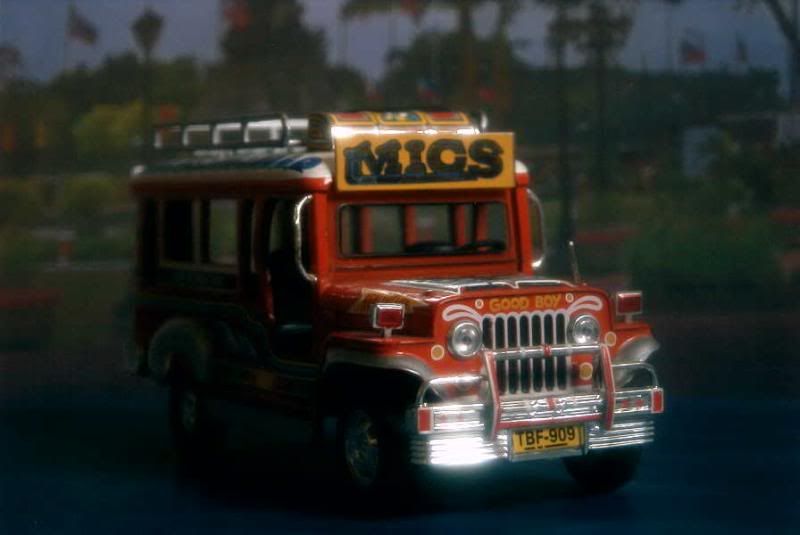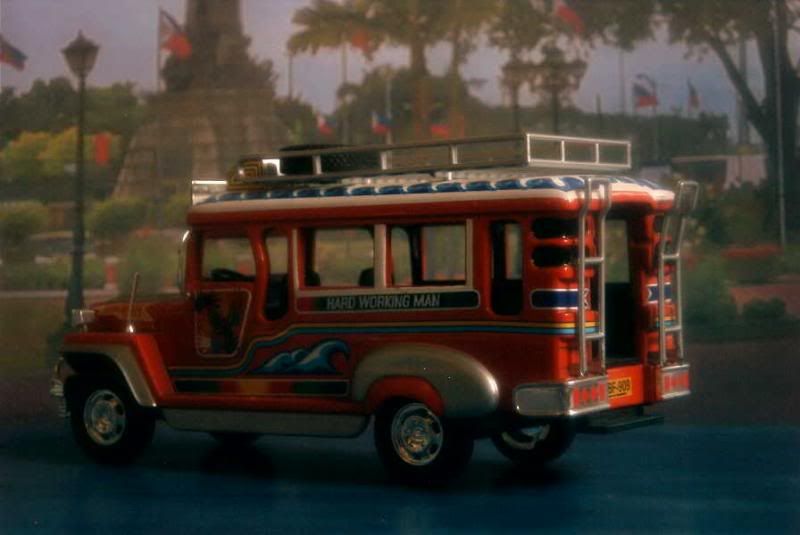A little history
The vehicle that was to become a Philippine icon started out as a hard times necessity. World War Two having almost entirely wiped out any form of public transportation throughout the archipelago, Filipinos had to do with the surplus jeeps the American troops had released into the local market, rather than bringing them all back home after the end of the conflict. Equipped with a metal roof to protect its passengers from the unforgiving tropical sun, fitted with all sorts of metal decorations and painted in bright colours, the typical jeepney was born.
By the time the original Willys-based jeepneys started to wear out, they were so embroiled into the Philippine landscape that these improvised vehicles simply couldn’t disappear anymore. Instead, they gave way to locally made versions, always bigger in order to accommodate an ever-increasing number of passengers keen of cheap but extremely spartan transportation. No longer related to American jeeps, these later versions were equipped with second-hand Japanese parts, engines generally being diesels, fitted into hand-made bodies. They still form the bulk of public transportation throughout the Philippines, though demands for environment-friendlier vehicles now add a few question marks to their future.
About the model
Model: Jeepney
Year: 1980
Maker: Ixo
Scale: 1/43
Distributed by: Altaya as no.14 of its Taxis du Monde press series
Acquired: second hand with mismatched stand and box, in October 2007, through mail from a fellow collector from Rouziers de Touraine, France
Ixo seems to have been the only company of international repute to have been interested in reproducing a jeepney. Though it sells a version under its own name, many collectors seem to have a preference for its Altaya equivalent, painted in bright orange colour (as far as I remember the “true” Ixo is blue). Jeepneys being, by essence, one-off cars, it is difficult to evaluate this model’s faithfulness to the original. Nonetheless, a few blameworthy details must be pointed out, most notably the modern commercial registration plate, which doesn’t fit the announced date; and the indication of the route followed by the vehicle, typically painted on each side and curiously absent here. Furthermore, the spare tyre, located on the roof, would have probably looked better behind the front left wing, blocking the access to the driver’s seat. Despite these drawbacks, Ixo have seized much of the jeepney’s spirit, and that’s already good enough: 12/20.
Note that, as the model went loose inside its non-original box after being shipped by its original owner, several small parts have been broken, including the side mirrors. Still not repaired to this day, they are absent on the following pictures.




The vehicle that was to become a Philippine icon started out as a hard times necessity. World War Two having almost entirely wiped out any form of public transportation throughout the archipelago, Filipinos had to do with the surplus jeeps the American troops had released into the local market, rather than bringing them all back home after the end of the conflict. Equipped with a metal roof to protect its passengers from the unforgiving tropical sun, fitted with all sorts of metal decorations and painted in bright colours, the typical jeepney was born.
By the time the original Willys-based jeepneys started to wear out, they were so embroiled into the Philippine landscape that these improvised vehicles simply couldn’t disappear anymore. Instead, they gave way to locally made versions, always bigger in order to accommodate an ever-increasing number of passengers keen of cheap but extremely spartan transportation. No longer related to American jeeps, these later versions were equipped with second-hand Japanese parts, engines generally being diesels, fitted into hand-made bodies. They still form the bulk of public transportation throughout the Philippines, though demands for environment-friendlier vehicles now add a few question marks to their future.
About the model
Model: Jeepney
Year: 1980
Maker: Ixo
Scale: 1/43
Distributed by: Altaya as no.14 of its Taxis du Monde press series
Acquired: second hand with mismatched stand and box, in October 2007, through mail from a fellow collector from Rouziers de Touraine, France
Ixo seems to have been the only company of international repute to have been interested in reproducing a jeepney. Though it sells a version under its own name, many collectors seem to have a preference for its Altaya equivalent, painted in bright orange colour (as far as I remember the “true” Ixo is blue). Jeepneys being, by essence, one-off cars, it is difficult to evaluate this model’s faithfulness to the original. Nonetheless, a few blameworthy details must be pointed out, most notably the modern commercial registration plate, which doesn’t fit the announced date; and the indication of the route followed by the vehicle, typically painted on each side and curiously absent here. Furthermore, the spare tyre, located on the roof, would have probably looked better behind the front left wing, blocking the access to the driver’s seat. Despite these drawbacks, Ixo have seized much of the jeepney’s spirit, and that’s already good enough: 12/20.
Note that, as the model went loose inside its non-original box after being shipped by its original owner, several small parts have been broken, including the side mirrors. Still not repaired to this day, they are absent on the following pictures.







No comments:
Post a Comment